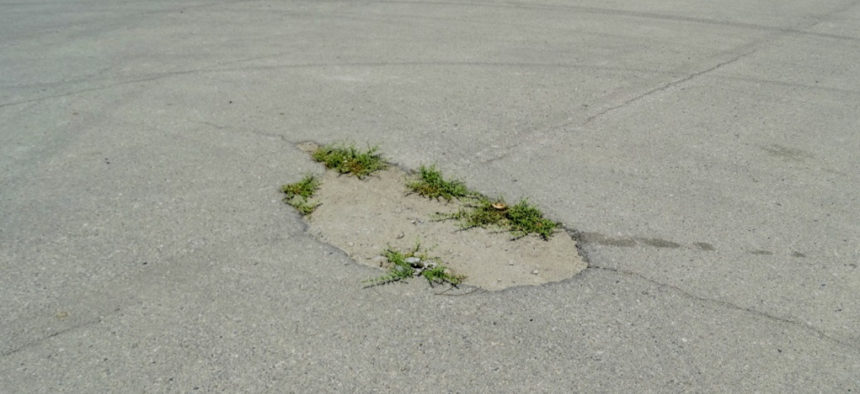
A cracked road in Bagrami. Special Inspector General for Afghanistan Reconstruction
Building Roads in War-Torn Afghanistan Remains a Tough Slog
Watchdog says $8.3 billion would be needed to halt decay.
Having invested $2.8 billion since 2002 to build roads in mountainous, war-weary Afghanistan, U.S. agencies now confront a network that is underfunded, poorly maintained and threatening to government stability, a watchdog found.
Without a new road improvement push, as much as $8.3 billion might be needed to replace the infrastructure that has in many places been destroyed by erosion or combatants, the Special Inspector General for Afghanistan Reconstruction said in a new audit.
“In addition to being maintained to a drivable standard, Afghanistan’s roads must be safe enough from insurgent attack to allow for travel and maintenance,” said the report, based on interviews with Afghan officials and staff at the Defense Department and U.S. Agency for International Development. “Afghanistan’s road infrastructure plays an important role in the country’s development and governance,” the watchdog added, “and if the Kabul to Kandahar highway were to become impassable, the central government would collapse."
SIGAR’s inspections of 1,640 kilometers (22 percent) of U.S.-funded national and regional highways found that as much as 20 percent of roads have been destroyed, and the rest continue to deteriorate. “The continued deterioration of the road infrastructure could weaken the Afghan government’s reach throughout the country, inhibit commerce and restrict the freedom of movement of Afghans,” the audit said.
Maintenance can be safely performed only when security conditions permit. At six of 20 road segments the SIGAR staff inspected, there were signs of insurgent activity, including 13 enemy checkpoints, according to the report.
Defense, which has largely phased out its road-building, and USAID were credited for some stability programs and largely complete accounting for expenses. “Although USAID could account for the program costs and locations for seven of the eight dedicated road construction programs, it could not provide precise location data for a $366 million Secondary Roads program,” auditors said.
The larger challenge is that “weak capacity, corruption, funding issues, and insecurity limit the [Ministry of Public Works’] ability to maintain Afghanistan’s road infrastructure,” the report added. “The lack of technical capacity within the ministry is a long-standing challenge.”
That ministry is relying on donors, and has not always proved a reliable partner to the U.S. nation-building program managers. “DoD followed guidance requiring that it obtain assurances from the Afghan government that road projects funded through [the $847 billion spent in its Commander’s Emergency Response Program] would be sustained,” the report said. “Unfortunately, the assurances given by the Afghan government were often unrealistic.”
SIGAR recommended that the USAID administrator condition future Afghan ministry funding to the successful creation of an independent Road Authority, Road Fund, and Transportation Institute. USAID agreed, noting that it has moved away from direct construction to creating technical expertise within the ministry.
The Pentagon said its road construction and maintenance activities in Afghanistan have largely concluded and that “while project sustainment was desired, other goals sometimes outweighed the potential risk that a project might not be sustained.”







